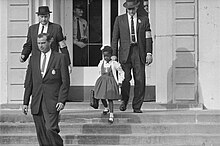William Frantz Elementary School
| William Frantz Elementary School | |
|---|---|
 William Frantz Elementary School in 2010 | |
| Address | |
 | |
3811 North Galvez Street , , 70117 | |
| Information | |
| School type | Elementary school |
William Frantz School | |
 | |
| Location | 3811 N. Galvez St., New Orleans, Louisiana |
|---|---|
| Coordinates | 29°58′35″N 90°01′59″W / 29.97639°N 90.03306°WCoordinates: 29°58′35″N 90°01′59″W / 29.97639°N 90.03306°W |
| Area | less than one acre |
| Built | 1937 |
| Built by | Herman T. Makofsky |
| Architect | E.A. Christy |
| Architectural style | Art Deco |
| NRHP reference No. | 05000557[1] |
| Added to NRHP | June 8, 2005 |
William Frantz Elementary School is an American elementary school located at 3811 North Galvez Street, New Orleans, Louisiana, 70117.[2][3] Along with McDonogh No. 19 Elementary School, it was involved in the New Orleans school desegregation crisis during 1960.
William Frantz Elementary School was one of the first all-white elementary schools in the Deep South to be integrated when Ruby Bridges became the first African-American student to attend the school. In 1960, when Bridges was six years of age, her parents responded to a request from the National Association for the Advancement of Colored People (NAACP) and volunteered her to participate in the integration of the New Orleans school system.
The school was built in 1937. It was designed in understated Art Deco style by the school board's architect E.A. Christy. It was listed on the National Register of Historic Places in 2005 as William Frantz School.[1][4]
In 2014, a statue of Ruby Bridges was unveiled in the courtyard of William Frantz Elementary School.[5]
Integration[]
In summer of 1960, Ruby Bridges was one of six African-American children in New Orleans to pass the test that determined whether or not the black children would go to the all-white school. However, two students decided to stay at their old school, and three were transferred to Mcdonogh No. 19. Ruby was the only one assigned to William Frantz. Her father was initially reluctant, but her mother felt strongly that the move was needed not only to give her own daughter a better education, but to "take this step forward ... for all African-American children." Her mother finally convinced her father to let her go to the school.[6]

The court-ordered first day of integrated schools in New Orleans, November 14, 1960, was commemorated by Norman Rockwell in the painting The Problem We All Live With.[7] As Bridges describes it, "Driving up I could see the crowd, but living in New Orleans, I actually thought it was Mardi Gras. There was a large crowd of people outside of the school. They were throwing things and shouting, and that sort of goes on in New Orleans at Mardi Gras."[7] Former United States Deputy Marshal Charles Burks later recalled, "She showed a lot of courage. She never cried. She didn't whimper. She just marched along like a little soldier, and we're all very very proud of her."[8]

The Problem We All Live With was later displayed in the White House during the presidency of Barack Obama.[9]
Post-integration[]
In 2005 Frantz was put on the National Register of Historic Places.[10] In 2005 New Orleans Public Schools was considering closing Frantz. Hurricane Katrina, which occurred that year, damaged the building. After it was restored, it began hosting the charter school Akili Academy.[11]
References[]
- ^ a b "National Register Information System". National Register of Historic Places. National Park Service. November 2, 2013.
- ^ Miller, Michelle (2010-11-12). "Ruby Bridges, Rockwell Muse, Goes Back to School". CBS Evening News with Katie Couric. CBS Interactive Inc. Retrieved 2010-11-13.
- ^ "Google Maps". Google Maps. Google Maps. Retrieved 2010-11-13.
- ^ Donna Fricker; Alison Bordelon (March 2005). "National Register of Historic Places Inventory/Nomination: William Frantz School / Frantz Elementary". National Park Service. Retrieved August 10, 2019. With accompanying six photos from 1994
- ^ "New Ruby Bridges statue inspires students, community". NOLA.com. Retrieved 15 November 2014.
- ^ Ruby Bridges Hall. "The Education of Ruby Nell," Guideposts, March 2000, pp. 3-4.
- ^ a b Charlayne Hunter-Gault. "A Class of One: A Conversation with Ruby Bridges Hall," Online NewsHour, February 18, 1997
- ^ Susannah Abbey. Freedom Hero: Ruby Bridges
- ^ L., DeNeen (2011-08-28). "Norman Rockwell painting of Ruby Bridges is on display at the White House". The Washington Post. Archived from the original on 2013-06-10.
- ^ Bridges, Ruby (2010-11-14). "50 years later, I'm still trying to integrate my school". Washington Post. p. 2. Retrieved 2016-12-08.
- ^ "New Life for the School Where Ruby Bridges Made History". The Huffington Post. 2014-03-13. Retrieved 2016-12-08.
External links[]
 Media related to William Frantz Elementary School at Wikimedia Commons
Media related to William Frantz Elementary School at Wikimedia Commons- William Frantz Elementary School at Vimeo.com
- Akili Academy of New Orleans
- School buildings on the National Register of Historic Places in Louisiana
- Art Deco architecture in Louisiana
- Buildings and structures completed in 1937
- Defunct elementary schools in New Orleans
- Public elementary schools in Louisiana
- Louisiana Registered Historic Place stubs

